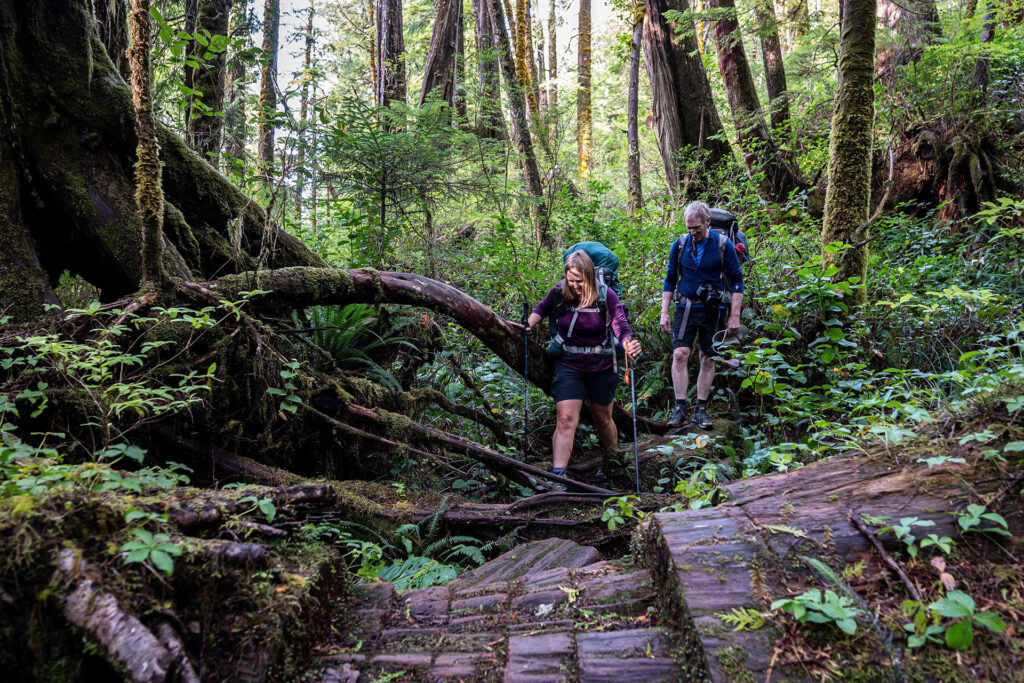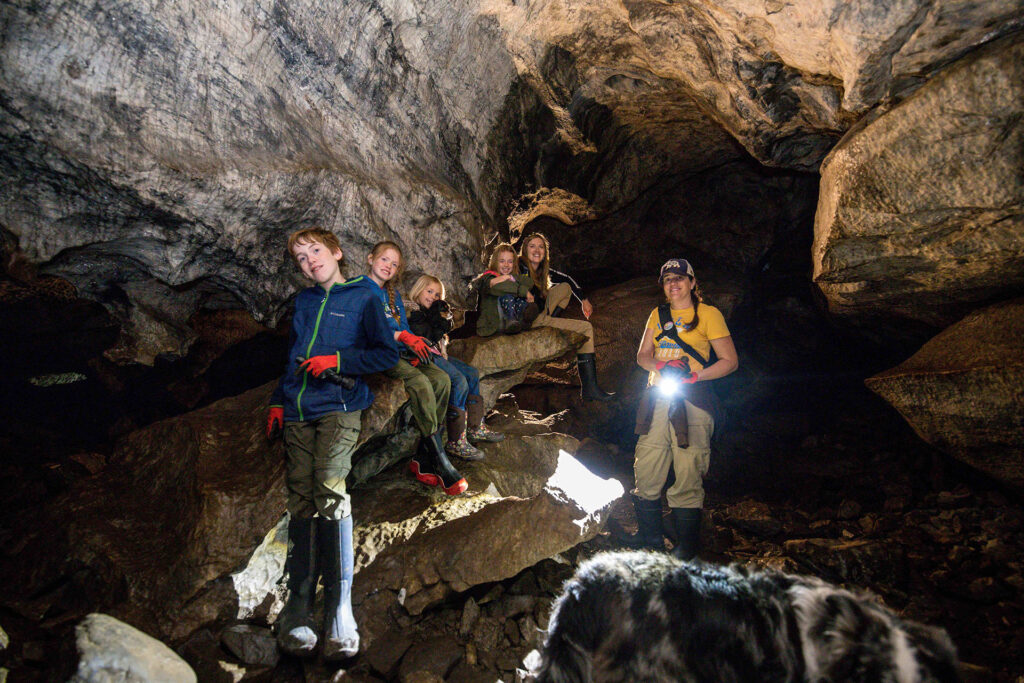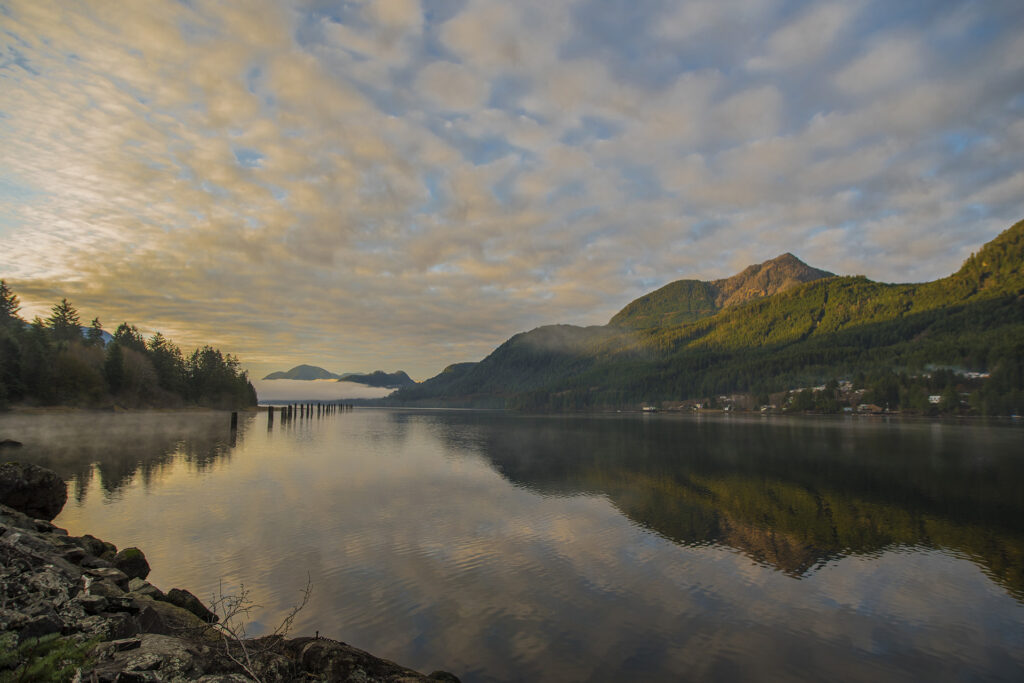
Community-based advisors for Tahsis and Mowachaht Muchalaht First Nation focus on eco-tourism growth.
The sun is just burning through the fog as the Shorebird Expeditions water taxi pulls away from the dock in Tahsis. The water is like glass, so it will be a smooth trip up Nootka Sound to Yuquot. The only other way to travel to the island is by float plane or the MV Uchuck III ship that makes the trip from Gold River on Wednesdays and Saturdays.
Located on the southern end of Nootka Island, Yuquot was the first National Historic Site in western Canada. Although it’s a small community, it’s vitally important in Mowachaht Muchalaht culture as the central place given to them by the creator. It’s home to more than 5,000 years of their history.
As few as 6 people reside in Yuquot, including the two year-round lighthouse keepers; however, it’s the official end of the Nootka Trail. The trail continues to grow in popularity, but it’s never crowded. It’s too wild and remote, which is its appeal to most people who choose to visit.
“Much of the area is wilderness,” says John Gauthier, Tourism and Marketing Officer with Mowachaht Muchalaht First Nation, “where people can access untouched wilderness.”
Revitalizing Nootka Through Cultural and Eco-Tourism

When Gauthier first started in his role, in June 2023, he spent six months reviewing existing infrastructure and creating a database for existing tourism services.
“There are very few First Nation-led tourism businesses in the territory,” says Gauthier, “so we focused on developing partnerships with existing businesses. We want to help build their capacity, especially in the shoulder seasons. By creating packages, we can make it easier for visitors to experience this beautiful region.”
The Mowachaht Muchalaht First Nation territory stretches from Strathcona Park’s Buttle Lake to the shores of Nootka Island. Like most rural areas on Vancouver Island, the primary roads were built to service the forestry industry, but pristine wilderness abounds. Local natural wonders, like Upana Caves, Haihte Range mountains that contain many of the largest remaining glaciers on Vancouver Island, and the calm waters of Nootka Sound, are truly unique.
The Mowachaht Muchalaht First Nation government is located just outside Gold River, where they’ve started multiple tourism development projects. The nation purchased and renovated the Gold River Chalet into the Baymont by Wyndham Hotel which is scheduled to open in May. They’re building a Welcome House, next to the hotel, that will provide territory information, cultural archives, and a retail area.
Gauthier also led an initiative to market the entire region as a single destination: Nootka.
“It’s something the province of Quebec has done very successfully,” says Gauthier, “segmenting the province into tourist destinations that offer unique experiences. We are branding the territory as the Nootka Region with the intention that consumers will identify the area for unique and exciting adventures.”
Their new website, Explore Nootka, is launching in April, providing visitors with an overview of tourism experiences in the region. More importantly, the website will make visiting the region easier while offering a wealth of information along with opportunities to book multi-day package experiences.
Local Tourism Businesses Diversify in Tahsis

Many of the listed tourism providers are in Tahsis. The village is a 90-minute drive from Gold River, along a road that is partially paved. Sport fishing, by visitors seeking charter opportunities and seasonal residents, has driven the local tourism market for years, but its stunning surroundings are transforming Tahsis into a budding eco-tourism destination.
“I am busy working with different businesses that can add to what Mowachaht Muchalaht is doing,” says Paige Sawyer, Rural Business Advisor, Village of Tahsis. “There has already been a really positive connection between businesses and experiences.”
Sawyer joined the Village of Tahsis staff in June, relocating to the community from the Kootenay region. Through a series of roundtables, she has engaged local businesses, highlighted growth opportunities, and identified challenges.
“Many of our business owners realize they need to diversify to broaden their customer base,” says Sawyer, “and that’s where John [Gauthier] comes in. He really wants to help our businesses grow the shoulder seasons and focus more on ecotourism.”
Both Gauthier and Sawyer pointed towards the Bikepacking.com Tree To Sea Route as an example. Created by Miles Arbour, the 1040-km loop circles north Vancouver Island. It follows the main road from Gold River to Tahsis, before continuing by water taxi to Zeballos.
“There are at least 500 cyclists coming in, so we are embracing it as an opportunity to identify accommodation and services for them,” says Sawyer. “Now Coal Creek Roasters is open earlier, and other businesses are pivoting their options to help accommodate anticipated tourists and bikepackers. Our marina is open from May through September, and food is available all day.”
There are a range of accommodation choices. A motel is currently being renovated and more Airbnb-style units enter the market each year. It’s still always encouraged to book visitor accommodations in advance, whenever possible.
“Many of the existing accommodation holders have focused on sport fishing,” says Sawyer, “but there is growing interest in eco-tourism opportunities.”
As Sawyer and Gauthier continue to collaborate and engage local businesses, they’re discovering new tourism opportunities.
“The Nootka region has many authentic ways to connect with nature,” says Gauthier, “and we’ll be presenting these to the public during the upcoming Vancouver Island Outdoor Show and other events across the island in April.”
In Tahsis, Sawyer will continue to focus on helping local businesses grow.
“We have a few small year-round businesses that are core to the community,” says Sawyer, “but there are so many business opportunities if we can get people to harness them.”
—
These two economic development positions have been funded through the community-based advisors’ stream of the Rural Advisory Program, which is delivered by Island Coastal Economic Trust on behalf of the Province of British Columbia. Both the Village of Tahsis and Mowachaht Muchalaht First Nation received $70,000, creating one-year term positions to provide business advisory services throughout their communities.
—